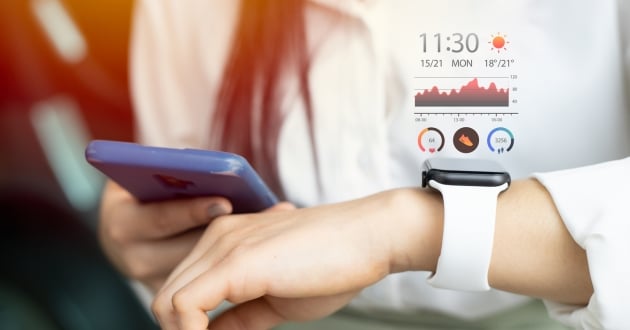Wearable devices for health and fitness have significantly impacted our daily lives, helping us monitor our well-being and achieve fitness goals through personalized insights.
As these devices continue to evolve, they’re being integrated with emerging technologies like augmented reality (AR), creating a world of possibilities for immersive, real-time feedback on our physical health. In the realm of technological advancement, wearable devices for health and fitness are at the forefront of a new era, where they contribute to proactive health management and foster healthier lifestyle habits.
The rise of wearable devices for health and fitness has led to a booming demand for AR-integrated solutions. Companies developing augmented reality applications for wearable technology focus on offering dynamic, interactive experiences that enhance health and fitness tracking. From visual cues during workouts to real-time heart rate analysis displayed in 3D space, AR is transforming how users interact with fitness data and engage with their health.
The Role of Augmented Reality Development Companies in Wearable Health and Fitness

Augmented reality development companies are key players in advancing wearable devices for health and fitness. These companies bring technological expertise to the table, enabling immersive experiences that can boost user engagement and enhance functionality.
By using AR, wearable devices can present real-time health data with augmented visuals, guiding users through personalized fitness regimens and enabling them to manage health metrics in a more interactive way.
Collaborating with these companies can give businesses the tools to offer users a deeper understanding of their health data in real-time, aiding their decision-making and helping them maintain an active lifestyle.
Augmented reality (AR) development companies play a transformative role in the wearable health and fitness sector by creating innovative solutions that enhance user experience and engagement. For instance, by integrating AR into wearable devices, users can visualize real-time data, such as heart rate and calories burned, overlaid onto their environment, thus making fitness tracking more immersive and interactive.
This evolution in wearable health tech demonstrates how AR can lead to both personal and global health improvements, shaping the future of fitness and wellness on multiple levels.
Technological Advancements in Augmented Reality for Health Wearables
In recent years, wearable devices for health and fitness have evolved from simple step counters to complex health monitors integrated with augmented reality features.
Modern AR-enabled wearables can track a wide array of health metrics like blood pressure, oxygen levels, and physical activity, presenting them in an easily interpretable format.
With augmented reality, users receive immersive feedback on their performance, such as visual indicators of exercise form or real-time progress bars that help in pacing and efficiency.
The integration of artificial intelligence and machine learning with AR applications has further amplified the accuracy and personalization of health monitoring. For example, AR-enabled wearables can adapt to a user’s specific fitness needs by analyzing past data, recommending specific exercises, and suggesting workout adjustments.
Technological advancements in augmented reality (AR) have significantly transformed the capabilities of health wearables, offering new opportunities for real-time monitoring and enhanced patient engagement. Notably, these developments enable wearables to overlay essential health data directly into the user’s field of vision, making information both accessible and actionable in moments of need.
Moreover, the integration of AR with artificial intelligence has further personalized the user experience. As it can adapt feedback based on individual health metrics and preferences.
Augmented reality development companies are driving this innovation by creating user-friendly interfaces and improving the precision of health data visualizations. Consequently, as AR technology progresses, health wearables are set to become even more indispensable tools for proactive health management.
Key Factors in Choosing Augmented Reality Development Companies for Wearable Health Solutions
Choosing the right augmented reality development company is crucial for any business seeking to launch or upgrade wearable devices for health and fitness. Here are four critical factors to consider:
1. Expertise in Health and Fitness Wearable Technologies
Not all AR companies specialize in health and fitness applications, so it’s essential to find a partner with proven expertise in wearable technology for health. Look for companies that have worked on similar projects or have experience with the specific metrics you aim to monitor.
2. Portfolio and Past Projects
Reviewing the past projects of AR development companies can provide insight into their capabilities and innovation level. An impressive portfolio with diverse applications showcases a company’s ability to adapt and create unique, effective solutions for wearable health devices.
3. Customization and Scalability
Health and fitness needs vary greatly between individuals, so AR applications for wearables must be highly customizable. Ensure the company you choose can provide scalable solutions that can evolve based on user feedback and technological advancements.
4. Data Security and Compliance
Since wearable devices for health and fitness often involve sensitive health data, data security and compliance are paramount. The ideal company should follow industry-standard data protection protocols and be compliant with healthcare regulations, such as HIPAA in the United States or GDPR in the European Union.
The Future of Augmented Reality in Wearable Devices for Health and Fitness
Augmented reality is poised to redefine how we engage with wearable devices for health and fitness. Future developments are expected to focus on creating even more immersive, holographic feedback systems where users can interact with 3D models of their own bodies, visualizing muscle engagement or posture correction in real-time.
This can enhance training efficiency, injury prevention, and personalized health tracking, making wearables essential tools for daily health management.
Emerging technologies like 5G and improved battery life in wearable devices will also boost AR applications, enabling faster data processing and continuous health monitoring without significant interruptions. With this new infrastructure, wearables can support more complex AR interactions and become an integral part of telemedicine, allowing real-time assessments and consultations from virtually anywhere.
How Augmented Reality Can Improve Mental Health through Wearables
While most wearable devices for health and fitness focus on physical health, augmented reality is opening new pathways for mental health support as well.
Through AR-enabled wearables, users can experience guided meditation, stress-relieving exercises, and even cognitive behavioral therapy techniques displayed in an engaging and interactive format. Visual cues in AR can help users practice mindfulness, manage anxiety, and develop healthier mental habits in real-time.
For instance, heart rate variability and other stress indicators can trigger AR-assisted relaxation techniques, instantly offering breathing exercises or calming visuals. Additionally, AR can create virtual environments that help reduce stress and anxiety, allowing users to experience nature scenes or calming visuals during high-stress moments.
Wearable devices have become essential tools for monitoring health and fitness, offering real-time insights into various physiological metrics. Here are three official platforms that provide comprehensive information and resources on these devices:
- WHOOP: Specializing in fitness trackers, WHOOP offers devices that monitor sleep, strain, recovery, and overall health. Their platform provides data-driven insights to help users optimize their performance and well-being.
- Oura Health: Known for the Oura Ring, a sleek wearable that tracks sleep patterns, heart rate, and activity levels, Oura Health offers detailed analytics to enhance personal wellness.
- Withings: Withings produces a range of smartwatches and fitness trackers that monitor heart rate, activity, and sleep. Their devices integrate seamlessly with health apps to provide users with a holistic view of their health metrics.
Conclusion
As the market for wearable devices for health and fitness expands, so does the need for cutting-edge AR applications that enhance user interaction and personalization. Augmented reality development companies play a pivotal role in driving these innovations, from creating immersive feedback systems to enabling remote health monitoring.
Selecting the right AR development partner can significantly influence the success of a health-oriented wearable product, ensuring it delivers value, remains user-friendly, and stays ahead of technological trends. With ongoing advancements in AR and wearable tech, the future of health and fitness is undoubtedly bright, immersive, and interactive.


